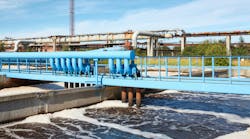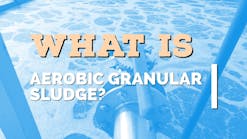What is an extended aeration plant?
Wastewater treatment package plants are treatment facilities used for treating wastewater in small communities. These plants can be designed to treat flows as low as 0.002 million gallons per day and as high as 0.5 million gallons per day.
An extended aeration plant is a type of package plant that, as the name implies, includes extended aeration. An extended aeration plant consists of a flow equalization, aeration, clarification, disinfection, and an aeration sludge holding/digestion segment all of which are compartmentalized. These plants are typically used in small municipalities where flow rates are below 0.1 million gallons per day.
Extended aeration is a part of the activated sludge process where oxygen is mixed with the wastewater resulting in a mixed liquor where the oxygen is used for the biodegradation of organic wastes.
The mixed liquor then flows to a clarifier or s settling chamber where most microorganisms settle at the bottom and a portion are pumped back to the incoming wastewater at the beginning of the plant. The clarified wastewater then flows over a weir and into a collection channel before it goes to the disinfection system.
Advantages and disadvantages of extended aeration
Extended aeration systems are easy to install and operate in addition to being odor free and producing relatively low sludge compared to other types of package plants such as sequencing batch reactors (Table 1). However extended aeration plants require additional unit processes to achieve denitrification and phosphorus removal - processes which require energy when aeration is done for long periods. One of the challenges of extended aeration is the flexibility it requires when there are updates in regulations for treating effluents (Table 1).
What is the difference between conventional and extended aeration?
Both conventional and extended aeration involve activated sludge processes. The difference between conventional aeration and extended aeration is that the aeration time is relatively longer in the extended aeration process (Table 2). Another difference is the characteristic of the activated sludge. The activated sludge in conventional aeration moves relatively faster through the different components. However, the highlight of the activated sludge in extended aeration is a low food to microorganism ratio (F/M ratio), and a long detention time in the aeration tank of more than 18 hours.
How does an extended aeration plant work?
The extended aeration plant involves several components, one of them being extended aeration, for the treatment of wastewater involving biological treatment. The EPA’s wastewater technology fact sheet on package plant illustrates the process flow diagram for a typical extended aeration plant. The influent after undergoing screening to remove large suspended or floating solids that could damage the equipment or interfere with the wastewater treatment process, then pass through a grinder to reduce the size of large particles that are not captured by the screen. The plant is equipped with a flow equalization to regulate the flow rate of the wastewater. The wastewater, after passing through the flow equalization chamber, enters the extended aeration chamber where it is mixed and oxygen is added to aid biological remediation resulting in a mixed liquor which them flows to a clarifier/settling chamber where most microorganisms settle to the bottom and a portion is pumped into the influent at the beginning of the plant. After going through the clarification chamber, the clarified wastewater then flows over a weir into the disinfection system.
What are the three types of aeration systems?
In addition to extended aeration, the other common types of package plants for wastewater treatment involving aeration and using the activated sludge process are sequencing batch reactors (SBRs), oxidation ditches, and aerated stabilization systems. A SBR and oxidation ditch are different yet share some similarities in the set-ups with the extended aeration systems while an aerated stabilization system is a simpler set-up.
In a SBR all biological treatment phases occur in one tank. A SBR also includes a disinfection tank and a digestion tank, as in extended aeration.
An oxidation ditch consists of a single or multi-channel configuration within a ring, oval, or horse-shoe shaped basin. The aerators provide aeration, oxygen circulation and transfer in the oxidation ditch. A typical process flow diagram for the oxidation ditch is similar to the extended aeration flow process in that the treated sewage flows from the oxidation ditch into the clarification tank where the biosolids and water separate. The oxidation ditch also includes a disinfection tank and a digestion tank, as in extended aeration.
An aerated stabilization basin consists of an aeration zone and a settling zone. Treatment occurs in the aeration zone and the treated wastewater then enters the settling zone where the remaining total suspended solids settles and then the treated water is discharged.
Why is extended aeration valuable for wastewater treatment?
An extended aeration treatment has many advantages over other activated sludge processes, the major advantage being, as summarized in Table 1, is that it is easier to operate and yields relatively low waste sludge compared to other activated sludge processes. It is also easier to install and to operate.
Another advantage of extended aeration, primarily due to the aeration being the highlight of extended aeration, is that it reduces ammonia levels in wastewater. Ammonia is a natural-occurring byproduct from the degradation of organic matter. The content of dissolved oxygen controls the level of ammonia in wastewater. The high amount of dissolved oxygen in extended aeration aerates the bottom of the aeration tank and so prevents the build up of ammonia in the wastewater. An extended aeration process is also referred to as a total oxidation process because the influent biological oxygen demand (BOD) is converted to carbon dioxide.
Extended aeration systems provide sufficient oxygen to allow aerobic biodegradation of the sewage into a disposable odor-free waste. It is a biological system to treat domestic wastewater due to its functionality and simplicity.





